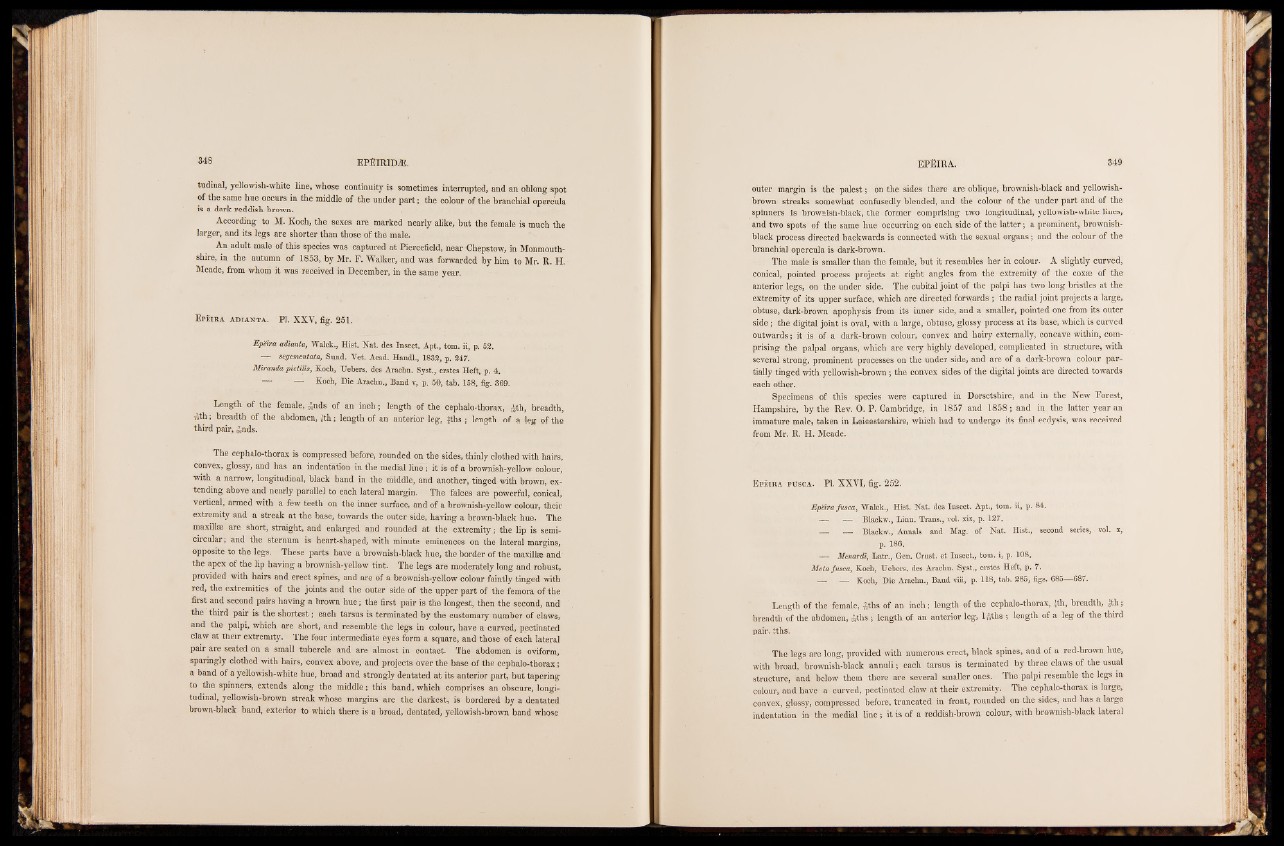
According to M. Koch, the sexes are marked nearly alike, but the female is much the
larger, and its legs are shorter than those of the male.
An adult male of this species was captured at Piercefield, near Chepstow, in Monmouthshire,
in the autumn of 1853, by Mr. F. Walker, and was forwarded by him to Mr. R. H.
Meade, from whom it was received in December, in the same year.
Epëira adianta. PI. XXV, fig. 251.
Epëira adianta, Walck., Hist. Nat. des Insect. Apt., tom. ii, p. 52.
—r* segementata, Sund. Yet. Acad. Handl., 1832, p. 247.
Miranda pictilis, Koch, Uebers. des Arachn. Syst., erstes Heft, p. 4.
— — Koch, Die Arachn., Band v, p. 50, tab. 158, fig. 369.
Length of the female, ^nds of an inch ; length of the cephalo-thorax, -^th, breadth,
i?th ; breadth of the abdomen, |th ; length of an anterior leg, fths ; length of a leg o f the
third pair, ^nds.
The cephalo-thorax is compressed before, rounded on the sides, thinly clothed with hairs,
convex, glossy, and has an indentation in the medial lin e ; it is of a brownish-yellow colour,
with a narrow, longitudinal, black band in the middle, and another, tinged with brown, extending
above and nearly parallel to each lateral margin. The falces are powerful, conical,
vertical, armed with a few teeth on the inner surface, and of a brownish-yellow colour, their
extremity and a streak at the base, towards the outer side, having a brown-black hue. The
maxillae are short, straight, and enlarged and rounded at the extremity; the lip is semicircular;
and the sternum is heart-shaped, with minute eminences on the lateral margins,
opposite to the legs. These parts have a brownish-black hue, the border of the maxillae and
the apex of the lip having a brownish-yellow tint. The legs are moderately long and robust,
provided with hairs and erect spines, and are of a brownish-yellow colour faintly tinged with
red, the extremities of the joints and the outer side of the upper part of the femora of the
first and second pairs having a brown hue; the first pair is the longest, then the second, and
the third pair is the shortest; each tarsus is terminated by the customary number of claws,
and the palpi, which are short, and resemble the legs in colour, have a curved, pectinated
claw at their extremity. The four intermediate eyes form a square, and those of each lateral
pair are seated on a small tubercle and are almost in contact. The abdomen is oviform,
sparingly clothed with hairs, convex above, and projects over the base of the cephalo-thorax;
a band of a yellowish-white hue, broad and strongly dentated at its anterior part, but tapering
to the spinners, extends along the middle; this band, which comprises an obscure, longitudinal,
yellowish-brown streak whose margins are the darkest, is bordered by a dentated
brown-black band, exterior to which there is a broad, dentated, yellowish-brown band whose
outer margin is the palest; on the sides there are oblique, brownish-black and yellowish-
brown streaks somewhat confusedly blended, and the colour of the under part and of the
spinners is brownish-black, the former comprising two longitudinal, yellowish-white lines,
and two spots of the same hue occurring on each side of the latter; a prominent, brownish-
black process directed backwards is connected with the sexual organs; and the colour of the
branchial opercula is dark-brown.
The male is smaller than the female, but it resembles her in colour. A slightly curved,
conical, pointed process projects at right angles from the extremity of the coxse of the
anterior legs, on the under side. The cubital joint of the palpi has two long bristles at the
extremity of its upper surface, which are directed forwards ; the radial joint projects a large,
obtuse, dark-brown apophysis from its inner side, and a smaller, pointed one from its outer
sid e ; the digital joint is oval, with a large, obtuse, glossy process at its base, which is curved
outwards; it is of a dark-brown colour, convex and hairy externally, concave within, comprising
the palpal organs, which are very highly developed, complicated in structure, with
several strong, prominent processes on the under side, and are of a dark-brown colour partially
tinged with yellowish-brown; the convex sides of the digital joints are directed towards
each other..
Specimens of this species were captured in Dorsetshire, and in the New Forest,
Hampshire, by the Rev. 0 . P. Cambridge, in 1857 and 1858; and in the latter year an
immature male, taken in Leicestershire, which had to undergo its final ecdysis, was received
from Mr. R. H. Meade.
Epeira fu sc a . PI. XXVI, fig. 252.
Epeira fusca, Walck., Hist. Nat. des Insect. Apt., tom. ii, p. 84.
—• . Blackw., Linn. Trans., vol. xix, p. 127.
— _ Blackw., Annals and Mag. of Nat. Hist., second series, vol. x,
p. 186.
. —- Menardi, Latr., Gen. Crust, et Insect., tom. i, p. 108.
Meta fusca, Koch, Uebers. des Arachn. Syst., erstes Heft, p. 7.
—- Koch, Die Arachn., Band viii, p. 118, tab. 285, figs. 685— 687.
Length of the female, ^ths of an inch; length of the cephalo-thorax, 5th, breadth, gth;
breadth of the abdomen, ^ths ; length of an anterior leg, l^ths ; length of a leg of the third
pair, iths.
The legs are long, provided with numerous erect, black spines, and of a red-brown hue,
with broad, brownish-black annuli; each tarsus is terminated by three claws of the usual
structure, and below them there are several smaller ones. The palpi resemble the legs in
colour, and have a curved, pectinated claw at their extremity. The cephalo-thorax is large,
convex, glossy, compressed before, truncated in front, rounded on the sides, and has a large
indentation in the medial line ; it is of a reddish-brown colour, with brownish-black lateral